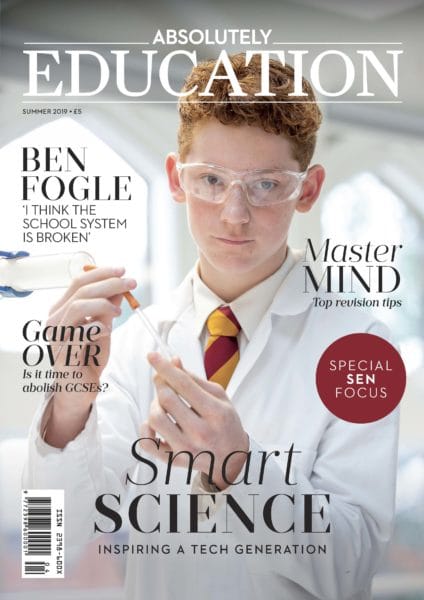How do schools deliver science and engineering subjects in a way that moves them beyond dry theory and into real life? Absolutely Education investigates how clever educators build both broader understanding and scientific connections

Gordon’s School
At Gordon’s School in Surrey, the team have worked hard to counteract the perception of science subjects as dry and ‘geeky’ and make them appealing to both girls and boys. It has worked, as STEM subjects are now attracting record numbers of pupils. This is also reflected in onward study choices, with science and health fields being popular university choices for all students.
The school says it has invested heavily in the infrastructure that brings science and engineering subjects to life, with a STEM hub, purpose-built Maths block (completed two years ago) and, even more recently, a Business and Computer Science suite. Another Science lab recently joined six others at the school and the Design Technology department has also been upgraded. “This is a new era for STEM at Gordon’s. We have invested heavily in the infrastructure and upgraded the facilities available as well as expanding what we offer to students,” says Deputy Head (Academic) Andrew Reeve.
“For Gordon’s younger students, creating solar-powered pancakes or learning how to make ice cream without a freezer have proved popular”
In the early stages of a student’s journey through STEM at Gordon’s, the emphasis is on building their curiosity and engagement, also relating subjects back to everyday life. Making solar-powered pancakes or lava lamps in an after-school club or learning how to create an endothermic reaction to make ice cream without a freezer have proved popular, unsurprisingly. Students in the younger years have also competed in the TeenTech Awards, designed to recognise innovation and creativity.
Older students are encouraged to develop their interests through co-curricular options such as Olympiads, CREST Awards, SATRO and Siemen’s competitions. An Inter-House Maths competition has joined the range of sports and arts competitions – adding to the traditional mainstays of intra-school battles. Outside school, students have participated in the UKBC Biology Challenge, which attracted 41,000 students from 550 schools. The challenge looks beyond the curriculum to information gleaned from other sources – including media and current affairs. An all-female coding club earned ‘Judges’ Favourite’ in the Global Innovators category of the Apps for Good Showcase with a food app that encouraged healthier and less wasteful diets.
Andrew Reeve sees student enthusiasm for science subjects, both in and out of the classroom, as hugely positive. “It’s an era of adventure and exploration within the curriculum and finding talent for something the students can take further in life. As well as Olympiads in biology, chemistry and physics, as part of our co-curricular academic options, there are countless opportunities for students to go above and beyond the curriculum.”
Gordon’s School gordons.school

Tonbridge School
At Tonbridge School in Kent, the £20m Barton Science Centre is a hub that makes STEM subjects come to life. Opened in 2019 by NASA astronauts and named after a Nobel prize-wining Tonbridge alumnus, it includes 20 state-of-the-art classrooms and labs across three floors. Practical and teaching spaces combine with libraries, a dedicated project lab, and interactive displays to inspire pupils. The spacious Atrium with giant TV wall used for presentations and visiting speakers is a very cool space indeed.
This whole way the centre is designed enables a focus on collaboration and practical work to improve communication skills, says Head of Science Nick Waite. The laboratories are with whiteboard walls and desks used extensively for problem-solving. “With the adage that the ‘most effective way to test a student’s understanding of a topic is to ask them to explain it to others, lessons will often include boys presenting their group’s work to the class,” he adds.
The approach at Tonbridge is to take science-based activities beyond the classroom as much as possible. “That can truly transform a student’s educational experience, and knowledge – and real-world applications will widen their scientific outlook,” says Nick Waite. Feeding academic curiosity is crucial, so first-hand investigation and enquiry are prioritised. At the Wednesday Afternoon Activities (WAA) Chemistry Research Group, for instance, Tonbridge boys joined forces with a local girls’ grammar to investigate Ionic Liquids. The group also visited Queen Mary University of London (QMUL), where students prepared their IL samples for NMR and IR spectroscopy analysis. This was an object lesson in real-life research, also providing the opportunity to acquire skills working with high-level scientific equipment.
“Last year, more than 100 students from schools across the UK came together to share their research at Tonbridge School’s Barton Science Centre”
The Tonbridge Student Science Conference, hosted annually at the Barton Science Centre, is an opportunity for students to present their research projects. Last year, more than 100 students from schools across the UK came together to share their research. This was a full programme, with 50 student presentation sessions plus display stands created by pupils from as far away as Los Altos High School in California. Students also enjoyed keynote speeches from three leading scientists.
The school has lots of extracurricular opportunities to build connections between STEM subjects. Multiple science clubs meet during the school day – Astronomy Club do so after dark when members have the opportunity to observe the night sky using the telescopes on the roof of the Barton. Nick Waite says it’s often the wackier projects that create the connections between science and life and spark curiosity. “When pupils are given the opportunity, for example, to design a rocket and fire it thousands of feet into the air at several hundred miles per hour, or to build an intricate puzzle box to stump the best ‘safe crackers’ amongst their peers, it creates a great sense of achievement and fun.
“A quote displayed in the Barton Science Centre sums up our philosophy on science enrichment activities: ‘Only attending the lessons is like opening a beer and just looking at it. Sure, you’ve made a start, but you’re missing the point….’.”
Alongside the in-school clubs and activities, Tonbridge hosts community events to spread the passion. This includes Science for Schools, which brings primary-school students into the school to participate in experiments that might not be possible at their own schools. In 2022-23, more than 300 Year 5 children were hosted. “Tonbridge boys take ownership of the activity and work individually with a small group of pupils,” says Nick Waite.
There are multiple competitions and challenges, internal and external, that Tonbridge pupils compete in – and with notable success. Some are designed to build teamwork across year groups, while others test innovation and problem solving to the limit. For instance, the Formula 24+ electric car racing series and the UKRoC youth rocketry competition.
Science and technology subjects are promoted for further study and careers. “We hold separate Careers Events each year at the school for Science, Engineering and Medicine, when we invite current professionals, universities and alumni (Old Tonbridgians) to speak about their experiences and careers,” says Nick Waite. He adds that students particularly love to hear about real-world careers applications.
Tonbridge School tonbridge-school.co.uk

Heathfield School
At Heathfield School in Ascot, the focus is on a lively and challenging syllabus with strong connections to the real world. Head of Science Lucy Johnson says it’s designed to inspire students to get a glimpse of the future scientists they could become. Enquiry processes and projects are incorporated into the teaching and learning scheme, engaging students and enabling them to make connections across the syllabus, and with other subjects.
There’s a huge focus, too, on fun and practical experiments and investigations that relate things back to the real world and spark a spirit of enquiry. Over the past year, students have investigated whether coffee will help spring onions to grow hydroponically, built wind turbines and solar-powered phone chargers, tested the strength of dog poo bags, determined which crisps would be the best for lighting fires in the wilderness and measured the concentration of catalase in different vegetables and hair types.
The Science Building at the school is designed to foster a ‘can do’ attitude, with the entire downstairs corridor displaying a photo-realistic mural of the timeline of scientific breakthroughs, with a focus on Women in Science – especially women of colour within STEM fields. Lucy Johnson, who is Teacher in Charge of Biology as well as Head of Science, says: “Facilities in our STEM building include specialist laboratories for each science subject, supported by subject-specific technicians. This enables us to build practical work into our teaching and learning, so we can support tricky or abstract concepts with experimental work and demonstrations”. The aim is to replicate the environment students will encounter within science-based environments and professional labs.
“Heathfield students have built wind turbines and solar-powered phone chargers and determined which crisps would be the best for lighting fires in the wilderness”
STEM is also taken beyond the classroom and lab. “Every year we have a range of trips across different year groups. These may include a trip to the farm with the lower school, a visit to a gin distillery with A-level Chemists, or the ever-inspiring Natural History Museum,” says Lucy Johnson. Tapping into both student interests and the future direction of careers, sustainability and the environmental impact of human activities are also prioritised. “A-level Biologists benefit from a residential trip to learn ecological and environmental sampling and study skills from the experts at the Field Studies Council. These trips help our students view science in a wider context.”
The Science team at Heathfield have been raising the profile of physics and engineering-related careers in recent years. Activities have included STEMKarts – with racetracks set up in the Sports Hall for a spot of high-energy racing with battery-operated go-karts. The fun is accompanied by serious science related to electric car technology, aerodynamics, design and sustainability. “This year we are entering the F1 in Schools UK competition and are planning to take a group of students to visit the McLaren Technology Centre,” adds Lucy Johnson.
There are plenty of extracurricular STEM-related activities through the year – from wildlife watching with motion-sensor night cameras to dissection club and designing siege weaponry. Every year, the school hatches ducklings and one of the most coveted Science Club positions is duck monitor – caring for and teaching the brood how to swim. “Science really does come to life at Heathfield!” says Lucy Johnson.
Heathfield School heathfieldschool.net

Malvern College
Malvern College, which sits in Worcestershire’s Malvern Hills, has a superb science setting in its state-of-the-art Science Centre, complete with multiple labs and prep rooms and a lecture theatre. With a full range of traditional science subjects on offer, there’s also a ground-breaking approach that brings STEM applications into the real world.
Young scientists at the school are asked to put their entrepreneurial hats on for the annual FY Challenge, which sees teams of budding scientists and inventors produce and market their own cosmetics brand. This is a challenge grounded in real-world industry because the UK health and beauty market is currently estimated to be worth £36 billion. With that in mind, Foundation Year (Year 9) students are tasked to look for an elusive gap in the market.
Malvern College sees this as a great example of inter-departmental working and sharing best practice, since Chemistry, Business, DT and Maths are all thrown into the mix – along with English, for good measure. The multi-day project this year kicked off with an insight into starting up an ethical cosmetics company, with a guest lecture by Old Malvernian Vicky Charlesworth, founder of JAYA Beauty. Further business acumen was then shared by teachers from English, Economics and Business who gave talks on ‘the analysis of advertising messages’, ‘what makes a good brand for a business’ and ‘pitfalls to consider when advertising in a different country’.
“Malvern College’s FY Challenge sees teams of budding scientists and inventors produce and market their own cosmetics brand”
With target market identified, the challenge progressed to the Chemistry department where raw materials were waiting to be transformed into a skin cream and lip balm. The critical and most challenging part of the manufacture was to make an emulsion of the correct consistency to be used as a skin cream. Beeswax and natural oils were carefully combined to form an emulsion, and essential oils were then added for fragrance. Once satisfied, the UV absorbance properties of the product had to be thoroughly tested. When the product had been manufactured in the lab, pupils return to the DT department to design and create their logo, packaging and point-of-sale display. The financial underpinning of their business plan was guided by the Maths department, who took the teams through the intricacies of costing and forecasting their business model.
The multi-discipline project, which happens every year over just three days, compresses what it takes to bring a new product to market. From initial inspiration to the R&D process, pupils must also consider the realities of how to sell the product. Every year, marketing involves pupils producing a short video for social media, and an advert for the overseas market, while the finale showcase pitch session to ‘potential’ investors sees pupils deliver sales presentations and respond to rigorous grilling on product, market and more in a Dragons’ Den-style session.
This annual challenge is included in all Year 9 timetables because, year-on-year, it has proved to be an exercise that pupils find inspiring and exciting. Not only does it allow them to apply real-world scenarios at each stage of the brief, but they also develop presentation skills and learn to work as part of a team while honing high-level STEM skills and seeing where their knowledge might lead.
Malvern College malverncollege.org.uk

The Duke of York’s Royal Military School
At DOYRMS in Kent, students (known as Dukies)have the option to study Engineering, Product Design and the Sciences, including Computer Science across GSCE, BTEC and A level. The school’s recent £24.9 million refurbishment included the creation of state-of-the-art science labs and engineering / design classrooms. Students have access to equipment such as 3D printers, laser cutters, a chip forge and brazing hearth.
The school is supported by industry sponsors the James Dyson Foundation, Secondary Engineer and Infineon Technologies, and all three contribute teaching resources to build on real-world understanding of engineering and STEM practices. Recently, students manufactured and tested WiFi antennas for Infineon Technologies, ensuring they were delivered on time and met client specifications. Students also go on lots of science and engineering trips. Recently, this included visiting CERN in Geneva. Activities outside the classroom and working with science and engineering institutions add invaluable real-life scenarios and hands-on experiences.
“DOYRMS students manufactured and tested WIFI antennas for Infineon Technologies, ensuring they were delivered on time and to client specifications”
The school has an extensive co-curricular programme, with over 80 weekly clubs and activities, many of them covering science and engineering. Inspired by James Dyson’s story, the school works on the basis that engineers and scientists share common characteristics – thinking outside the box and perseverance. Teachers across subjects work together to ensure DOYRMS students understand stretches across subject areas. Theories and knowledge learnt in the science classroom is often put into practice in engineering lessons, and vice versa.
With industry sponsors in the mix, students here take part in real-life challenges and create STEM products – some of which have gone on to be used within the industry and developed further. There’s a close working relationship with the school’s careers team, who help children unlock their passions and strengths and consider future opportunities.
The Duke of York’s Royal Military School doyrms.com

Pangbourne College
At Pangbourne College in Berkshire, live science is firmly in the mix – and with plenty of space allocated for practical work. The outdoor classroom is a recent addition. Head of Science and Physics Dr Katerine Richard says this is particularly useful when extra space is required for experiments such as ‘whirling bung’. It’s also useful for messy jobs such as planting peas. “We place great emphasis on practical equipment being ‘old fashioned’ – rulers, stop watches, and so on, through to cutting edge (e.g., Vernier motion analysis software and Globisens data acquisition modules). This is because we know that pupils need a range of ways of interacting with the taught content,” she says.
This flexible approach to tap into children’s learning style extends to learning opportunities beyond the classroom. There are whole-year-group trips to broaden everyone’s exposure to science. Useful, says Katerine Richard, whether they go on to be research or citizen scientists. “At the other end, we provide opportunities – for specific classes, groups of pupils or individuals – from external competitions, speakers invited to chat and answer questions with a single class to going out to support teaching of science in primary schools. We place great emphasis on opportunities being cross-curricular.”
There’s a vibrant extracurricular programme designed to work alongside academic study. Opportunities develop up the school, starting with Science Club for Year 7 and evolving into CREST Awards and the STEM Ambassador programme in Sixth Form. These pupil ambassadors support the Science Department in promoting careers and other opportunities and assist with the school’s annual Science Week. There’s also lots of joined-up departmental thinking at Pangbourne – for instance a joint KS3 Science and Geography trip to see wind turbines and solar farms at work, followed by a visit to a nearby town to do a sustainability survey.
“Engineering-related projects at Pangbourne include the design and manufacture of an electric car, but also classic car restoration projects”
Students at Pangbourne also acquire ‘maker doer’ skills via the comprehensive Design Technology facilities and teaching. The large mixed media workshop has metal, wood and plastics processing machines, plus large format laser cutter 3D printers and a CNC router. Tools develop basic hand skills in lower years, with increasingly sophisticated applications as students progress. The aim is to get children’s critical thinking to the stage where they can tackle a design and manufacture task from ideation to production.
Fun DT-inspired and engineering-related projects at the school include the design and manufacture of an electric car, but also popular classic car restoration projects. The KS3 Challenge Club in DT enables pupils to enter national competitions and resolve design-based problems. Everyone is looking forward to the national competitions promised in the future by the school’s emerging Electric Car Club. This four-wheeled challenge is a classic example of science being brought right up to speed and into real life.
Pangbourne College pangbourne.com
Further reading: Healthy competition – why school sports are so important
You may also like...


























